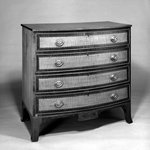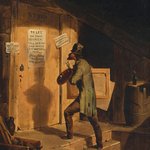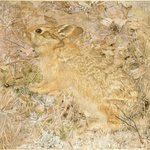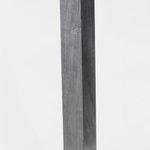
Side Chair
Decorative Arts and Design
The design of this chair, unlike those of previous eras, does not rely on models from the distant past, “exotic” cultures, or direct observation of nature. Rather, it is expressed in the new, modern language of abstraction based on geometry and planes. Frank Lloyd Wright rejected nineteenth-century concerns about comfort, decoration, and coloration in favor of a simple and unencumbered design that seeks to express the essence of what a chair is.
MEDIUM
Oak, upholstery
DATES
1904
DIMENSIONS
40 1/8 x 14 3/4 x 18 1/2in. (101.9 x 37.5 x 47cm)
Seat height: 17 in. (43.2 cm) (show scale)



MARKINGS
no marks
SIGNATURE
no signature
INSCRIPTIONS
no inscriptions
COLLECTIONS
Decorative Arts and Design
ACCESSION NUMBER
83.157a-b
CREDIT LINE
Designated Purchase Fund
CATALOGUE DESCRIPTION
Oak side chair (a) with reupholstered slip seat (b). Chair: rectilinear, composed entirely of pieces assembled at right angles, with the exception of the back which is a thin plank of oak that runs, at a slight diagonal, from above and between the tops of the single piece stiles, down into the leg stretcher. Slip seat slips from the seat frame.
Condition: Fair, due to usage, crispness of all edges and corners is lost.More detailed condition notes:
Most noticeable wear as follows (top to bottom): top edge of back, slightly marred to proper left, with small, old chip with slight (ca. ½") loss; to proper right is small area with traces of red paint (ca. 1"); top proper right corner of back with chip resulting in nearly complete loss of corner (damaged area ca. ¾" long); slightly below, at back edge, is small dent with tiny loss. Top, proper right stile block with horizontal loss to outside edge (ca. 5/8"). Vertical splits to top of proper left stile on inside (ca. 1 ¼") and rear 3 ½'. Outside edges of flat back, at juncture with seat, with indentation on both sides where seat fits in. Front corners of seat frame very worn and separating somewhat, with slight losses to all corner edges. Front rail bows slightly causing separation at proper right corner. Scuff marks, bruising, and scratches to front side of flat back at juncture with seat. Inside of seat rails with numerous old repairs. Dried glue and other matter stuck between pieces. Two small blocks that sit on top of left and right rails at back probably replacements. Nails are driven from inside through proper right seat rail. Piece of veneer that originally covered proper left stretcher from back of cross-stretcher to stile, is almost gone. Opposite side retains veneer, but is popping off in middle. Front of proper right leg with three noticeable vertical splits, with small losses, toward inside edge. Glides added to all four feet. Two small parts of top back rail that are exposed to front are noticeably lighter than other surfaces, probably due to cleaning, which had to be done against the grain. Rear cross-stretcher held in not with wood pegs, but with metal bolts. Seat (b) has been re-upholstered with red vinyl. Vinyl is worn and stained and should be replaced with leather. Largest stain is to top center near rear. Gauze-like fabric under seat loose and torn throughout.
Rear cross-stretcher held in not with wood pegs, but with metal bolts. Seat (b) has been re-upholstered with red vinyl. Vinyl is worn and stained and should be replaced with leather. Largest stain is to top center near rear. Gauze-like fabric under seat loose and torn throughout.
EXHIBITIONS
MUSEUM LOCATION
This item is not on view
CAPTION
Frank Lloyd Wright (American, 1867–1959). Side Chair, 1904. Oak, upholstery, 40 1/8 x 14 3/4 x 18 1/2in. (101.9 x 37.5 x 47cm). Brooklyn Museum, Designated Purchase Fund, 83.157a-b. Creative Commons-BY (Photo: Brooklyn Museum, 83.157a-b_bw.jpg)
IMAGE
overall, 83.157a-b_bw.jpg. Brooklyn Museum photograph
"CUR" at the beginning of an image file name means that the image was created by a curatorial staff member. These study images may be digital point-and-shoot photographs, when we don\'t yet have high-quality studio photography, or they may be scans of older negatives, slides, or photographic prints, providing historical documentation of the object.
RIGHTS STATEMENT
Creative Commons-BY
You may download and use Brooklyn Museum images of this three-dimensional work in accordance with a Creative Commons license. Fair use, as understood under the United States Copyright Act, may also apply.
Please include caption information from this page and credit the Brooklyn Museum. If you need a high resolution file, please fill out our online application form (charges apply).
For further information about copyright, we recommend resources at the United States Library of Congress, Cornell University, Copyright and Cultural Institutions: Guidelines for U.S. Libraries, Archives, and Museums, and Copyright Watch.
For more information about the Museum's rights project, including how rights types are assigned, please see our blog posts on copyright.
If you have any information regarding this work and rights to it, please contact copyright@brooklynmuseum.org.
RECORD COMPLETENESS
Not every record you will find here is complete. More information is available for some works than for others, and some entries have been updated more recently. Records are frequently reviewed and revised, and we welcome any additional information you might have.
















































